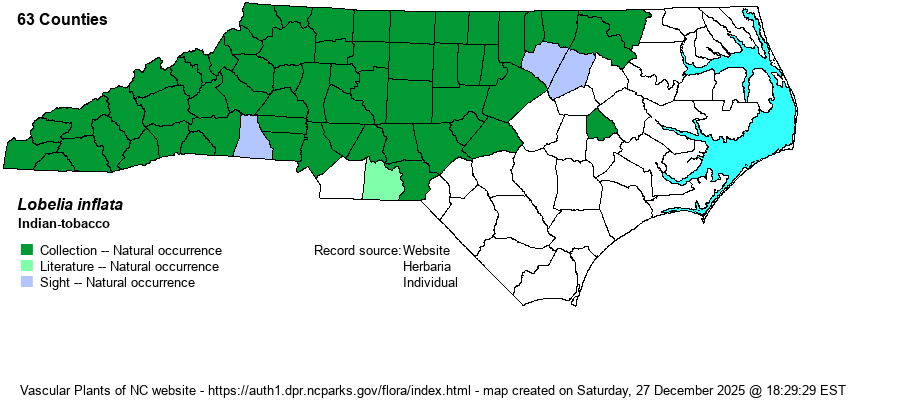| Author | L. | |
| Distribution | Throughout the Mountains and Piedmont. Barely ranges into the western edge of the Coastal Plain, sparingly east to Greene County.
This is a very widespread species in the East, found in nearly every county in the range. It occurs from eastern Canada south to central portions of GA and AL, and barely to LA.
| |
| Abundance | Common and widespread in the Mountains and Piedmont; very rare to rare into the edge of the Coastal Plain. | |
| Habitat | This is one of the few Lobelia species that is not a requisite wetland species. It occurs in many upland habitats, usually in mesic soil. It grows along wooded borders and in openings, fields and meadows, powerline clearings, and vacant lots. In many ways, it appears to be an exotic species, even though it is a native species. |
| Phenology | Blooms from July to frost, and fruits soon after flowering. | |
| Identification | This is a very easy species to identify, familiar to all biologists. It is an erect species with numerous ascending branches, to about 2 feet tall, and quite hairy throughout. The numerous alternate leaves are 2-3 inches long, about 1-inch wide, elliptical to ovate, and serrated on the margins. The upper 6 inches of the stem is the slender raceme, of numerous pale blue (to rarely white) flowers, each quite small for a Lobelia, mostly just 3/10-inch long. Immediately after flowering, the base of the flower becomes greatly inflated into a sphere or a "small football" shape. Normally, you will see at least a few such inflated flowers near the bottom of the raceme while some of the upper flowers are still in bloom. | |
| Taxonomic Comments | None
| |
| Other Common Name(s) | Though Indian-tobacco is an idiosyncratic name, essentially all references for decades have given the plant this name, with essentially no alternative using "Lobelia" in the common name. | |
| State Rank | S5 | |
| Global Rank | G5 | |
| State Status | | |
| US Status | | |
| USACE-agcp | FAC link |
| USACE-emp | FACU link |

